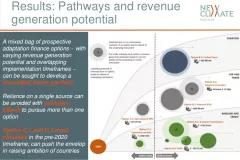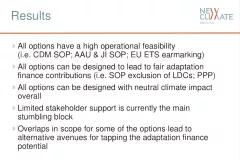Parties will take important decisions about the future of the Adaptation Fund at COP 24 in Katowice, Poland. This paper provides recommendations for those negotiations specifically regarding the Fund’s operating modalities including future mobilisation of sources of finance; safeguards; and governance.
NewClimate Institute contributed to this Germanwatch publication.
Key Conclusions
As the climate warms, mobilising and effectively disbursing climate adaptation finance becomes ever more important to reduce vulnerability and increase climate resilience. The Adaptation Fund, with over 10 years of experience in channelling adaptation finance, has a unique function in the international climate finance architecture and the global response to the impacts of climate change. With its distinct mandate, clear specialisation, and innovative features, the Adaptation Fund can play an important role in improving the quality of adaptation finance.
This paper explores the Fund’s role in the future climate finance architecture, taking into account past and current debates in international climate negotiations. Importantly in December 2018, at the 24th Conference of the Parties (COP 24) to the United Nations Framework Convention on Climate Change (UNFCCC) in Katowice, Poland, important decisions are expected to be made regarding operating modalities including future mobilisation of sources of finance; safeguards; and governance of the Adaptation Fund. The main part of this paper covers these three areas and aims to provide background information, as well as recommendations, for improving the Adaptation Fund’s operations and securing its future.
Specifically, with regard to the mobilisation of sources of finance for the Fund, while a share of proceeds from the Clean Development Mechanism (CDM) historically played an important role – this source is not sufficient to meet current or future needs. The future of the CDM and its relation to Article 6 of the Paris Agreement are unclear. In order to ensure more reliable finance, Parties should explore a potential link with Article 6 of the Paris Agreement, emphasize the need for additional and diverse sources of finance such as earmarked proceeds from national ETSs, carbon taxes, and possibly a levy on maritime emissions while emphasising the need for further governmental contributions.
To secure a future for the Fund under the Paris Agreement and enable it to work as effectively as possible, climate negotiators need to act at the upcoming climate conference in Katowice. We hope this publication, with concrete recommendations for COP24, will contribute to this outcome.






